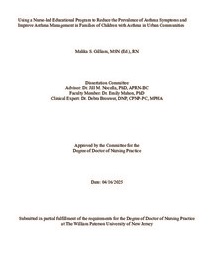Please use this identifier to cite or link to this item:
http://hdl.handle.net/20.500.12164/3489Full metadata record
| DC Field | Value | Language |
|---|---|---|
| dc.contributor.author | Gilliam, Malika Sade | - |
| dc.date.accessioned | 2025-05-22T20:29:03Z | - |
| dc.date.available | 2025-05-22T20:29:03Z | - |
| dc.date.issued | 2025-05-20 | - |
| dc.identifier.uri | http://hdl.handle.net/20.500.12164/3489 | - |
| dc.description.abstract | Background: Asthma is a chronic, non-communicable lung disease that has become a significant public health issue in the United States, particularly among children and adolescents. Beyond its impact on health, asthma also represents a substantial economic burden on the healthcare system due to the costs of treatment and management. Problem: Children and adolescents in low-income communities are disproportionately affected by asthma, resulting in increased morbidity. Contributing factors to these disparities include inadequate housing, exposure to pollution, and environmental allergens. Purpose: This study aimed to test the impact of educational intervention in improving asthma symptom management and medication adherence among families of children with asthma. A nurse-led intervention was implemented to explore the effectiveness of educational strategies in enhancing asthma management in an urban community setting. Method: A quantitative and qualitative research approach was utilized. Data was collected before and after the educational intervention using the Pediatric/Adolescent Asthma Therapy Questionnaire and the Inhaler Device Assessment Tool. The data were analyzed using SPSS software to evaluate the impact of the intervention. Results: Data from 23 caregivers of children with asthma were analyzed. The results indicated that the nurse-led educational intervention significantly improved medication adherence and the correct use of inhaler devices, with caregivers demonstrating an average score increase of 2.23 points. However, no statistically significant improvements were observed in asthma control, attitudes and behaviors, self-efficacy, or patient-provider communication. Despite the lack of statistical significance in some areas, the study underscores the continued need for educational programs to foster better health outcomes for children with asthma. | en_US |
| dc.format.extent | 80 pages | en_US |
| dc.language.iso | en_US | en_US |
| dc.publisher | William Paterson University | en_US |
| dc.subject | Nursing | en_US |
| dc.subject | Asthma education program | en_US |
| dc.subject | Asthma management | en_US |
| dc.subject | Asthma medication management | en_US |
| dc.subject | Asthma symptoms | en_US |
| dc.subject.lcsh | Nursing | en_US |
| dc.title | Using a Nurse-led Educational Program to Reduce the Prevalence of Asthma Symptoms and Improve Asthma Management in Families of Children with Asthma in Urban Communities | en_US |
| dc.type | Dissertation | en_US |
| Appears in Collections: | Theses & Dissertations | |
Files in This Item:
| File | Description | Size | Format | |
|---|---|---|---|---|
| Gilliam_UrbanAsthmaEducation.pdf | 1.63 MB | Adobe PDF |  View/Open |
Items in DSpace are protected by copyright, with all rights reserved, unless otherwise indicated.
